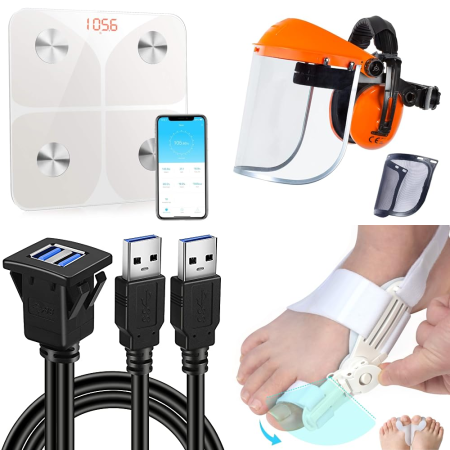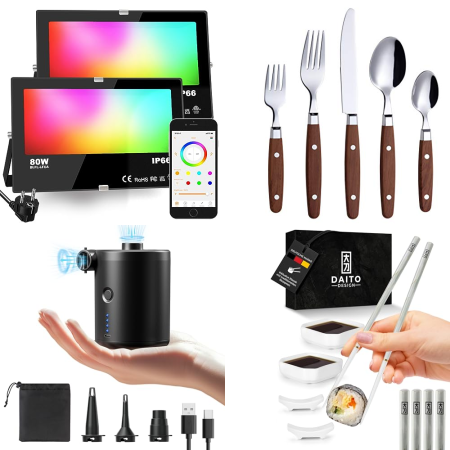Sie haben gerade ein Angebot gefunden: 1.000 B-Grade-Smartphones zu 70 % unter dem Einzelhandelspreis. Sollten Sie auf Kaufen klicken?
Bevor Sie diese Entscheidung treffen, müssen Sie den Unterschied zwischen A-Grade- und B-ware-Produkten kennen. Viele Wiederverkäufer verlieren Geld nicht wegen falscher Preise, sondern weil sie nicht verstanden haben, was B-ware tatsächlich bedeutet.
Lassen Sie uns das klar und ohne Umschweife erklären. Dieser Artikel führt Sie durch echte Definitionen, Beispiele, Risiken und zeigt, wie Sie sicher von B-Grade-Bulk-Inventar profitieren können.
Was sind Produktgrade & warum sind sie wichtig
Produktgrade sind Klassifikationen, die den Zustand, die Qualität und die Funktionalität eines Produkts anzeigen. Sie sind wichtig, weil sie Wiederverkäufern helfen, Artikel genau zu bewerten, wettbewerbsfähige Preise festzulegen und Kundenzufriedenheit sicherzustellen. Beispielsweise zeigen Leitfäden wie das Refurb.me-Grading-System und der ITPro-Leitfaden für generalüberholte Produkte, wie stark die Bewertung den Wiederverkaufswert, die Rücklaufquoten und das Vertrauen der Käufer beeinflusst und machen sie zu einem kritischen Faktor für jeden, der Produkte in großen Mengen kauft.
Verstehen von Produktgraden
Was ist A-Grade?
A-Grade-Produkte sind wie neu. Sie sind voll funktionsfähig, zeigen minimale Abnutzung und enthalten oft die Originalverpackung und Zubehör (Refurb.me). Diese Produkte stammen häufig aus Überbeständen, Demo-Einheiten oder ungeöffneten Rücksendungen.
Was ist B-Ware?
B-ware-Produkte funktionieren einwandfrei, zeigen jedoch sichtbare Gebrauchsspuren – Kratzer, Schrammen, verblasste Logos usw. Sie stammen in der Regel aus offenen Rücksendungen oder Demo-Einheiten. Sie sind weiterhin funktionsfähig, aber nicht optisch einwandfrei (Liquidation Stock). Diese Produkte können auch die Originalverpackung oder Zubehör fehlen, werden jedoch auf funktionale Standards getestet.
Kein universeller Bewertungsstandard
Es gibt kein globales Regelwerk für Produktgrade. Verschiedene Anbieter definieren Grades unterschiedlich. EuroConsumers stellte erhebliche Inkonsistenzen bei der Klassifizierung von generalüberholten Elektronikprodukten fest. Einige Verkäufer stufen kosmetische Schäden als B-ware ein, während andere kleinere funktionale Probleme in dieselbe Kategorie einordnen. Dies macht eine sorgfältige Prüfung entscheidend.
Wie sich die Bewertung in verschiedenen Branchen unterscheidet
· Elektronik: Strenge visuelle und funktionale Tests gelten für Geräte wie B-ware-Laptops und Smartphones. Kratzer auf Bildschirm oder Gehäuse führen in der Regel zu B-ware.
· Bekleidung: Kleidung mit Etiketten und ohne Mängel gilt als A-Grade. Fehlen Etiketten oder ist die Naht locker, ist es B-ware.
· Haushaltsgeräte: Dellen oder Kratzer auf Oberflächen von Kühlschränken oder Mikrowellen kennzeichnen B-ware, selbst wenn sie voll funktionsfähig sind.
· Kosmetik: A-Grade bedeutet versiegelte Verpackung. B-Grade umfasst geöffnete, aber unbenutzte Produkte oder Artikel mit beschädigten Verpackungen.
· Möbel: Ausstellungsstücke mit kleinen Absplitterungen oder Dellen werden in der Regel als B-Grade verkauft.
· Werkzeuge: Zurückgesandte oder leicht genutzte Gegenstände, die noch funktionieren, fallen unter B-ware. Sie können in generischer Verpackung geliefert werden.
Wesentliche Unterschiede zwischen A-Grade und B-Ware
|
Feature |
A-Grade |
B-Grade |
|
Kosmetischer Zustand |
Wie neu |
Sichtbare Abnutzung |
|
Funktionalität |
Vollständig getestet |
Vollständig getestet, möglicherweise zusätzliche Überprüfungen nötig |
|
Verpackung |
Original-Einzelhandelsbox |
Generisch oder umverpackt |
|
Garantie |
Oft herstellerunterstützt |
In der Regel Wiederverkäufer-/Refurbisher-Garantie |
|
Preis |
Höher |
30 %–70 % niedriger (Mordor Intelligence) |
Branchen-spezifische Bewertungsbeispiele
B-Ware Elektronik
Dazu gehören Telefone, Tablets und B-Grade-Laptops. Sie bestehen Funktionstests, zeigen jedoch kosmetische Mängel. Refurb.me erklärt ihr System detailliert. Plattformen wie Back Market und Amazon Renewed verwenden häufig solche Bewertungssysteme.
B-Ware Haushaltsgeräte
Erwarten Sie Dellen oder Oberflächenkratzer bei Geräten wie Waschmaschinen oder Öfen. Einige Wiederverkäufer beziehen diese aus Überbeständen oder Rückläufen.
B-Ware Bekleidung
Oft Rückläufer oder Muster aus dem Laden. Diese Artikel können Verpackung fehlen oder leichte Anprobierspuren aufweisen.
B-Ware Kosmetik
Unversiegelt, aber unbenutzt. Meist nur beschädigte Verpackung. Prüfen Sie immer das Ablaufdatum und Sicherheitsvorschriften vor dem Wiederverkauf.
B-Ware Werkzeuge & Hardware
Zurückgesandte oder getestete Einheiten, möglicherweise mit Gebrauchsspuren wie Farbspritzern oder Gummiverwendung. Funktional, aber nicht makellos.
B-Ware Möbel
Ausstellungsstücke oder kleine Mängel wie abgebrochene Kanten oder verkratzte Beine. Häufig bei Liquidationen von Showroom-Beständen.
Vor- und Nachteile für Wiederverkäufer
Vorteile von A-Grade
· Einfacher zu listen und zu fotografieren
· Geringere Rücklaufquoten
· Höherer Wiederverkaufswert
· Oft vom Hersteller unterstützt
Nachteile von A-Grade
· Höhere Anschaffungskosten
· Niedrigere Gewinnspanne
· Stärker umkämpfte Listings
Vorteile von B-Ware
· Niedrigere Beschaffungskosten
· Höheres Gewinnpotenzial
· Nachfrage bei Schnäppchenjägern
· Möglichkeiten zur Wertsteigerung durch Refurbishing
Nachteile von B-Grade
· Mehr Zeit für Inspektion erforderlich
· Höhere Rücklaufquoten
· Zusätzliche Tests und Sortierung nötig
· Oft fehlen Originaldokumente oder Zubehör
Preise, Margen & Rentabilität
Kostenunterschiede
A-Grade kostet mehr im Voraus. B-Grade wird oft mit 30–70 % Rabatt angeboten, abhängig von der Kategorie. Bulk-B-Grade-Elektronik und B-Grade-Smartphones bieten typischerweise die größte Preisflexibilität.
Gewinnspannen
Branchendaten zeigen:
ROI-Aufschlüsselung
· A-Grade = sicherer ROI, langsamer Umsatz
· B-Ware = höhere Marge, schnellerer Umsatz, mehr Risiko
· A-Grade eignet sich für Marktplätze wie Amazon, bei denen Zustandsstandards streng sind.
· B-Ware funktioniert gut auf Plattformen wie eBay oder spezialisierten Refurb-Marktplätzen.

Käuferpsychologie & Kundenerwartungen
Wer kauft A-Grade?
· Markenbewusste Käufer
· Geschenkekäufer
· Qualitätsorientierte Nutzer
Wer kauft B-Ware?
· Budgetbewusste Käufer
· Umweltbewusste Nutzer
· Schnäppchenjäger
Bewertung & Rücklaufquoten
Rücklaufquoten steigen, wenn Beschreibungen nicht dem Zustand entsprechen. B-Grade-Mängel offenlegen.
Wie Erwartungen gemanagt werden
· Mehrere klare Fotos verwenden
· Kosmetischen und funktionalen Zustand beschreiben
· Zubehör oder Handbücher erwähnen, falls fehlen
Finale Checkliste für Wiederverkäufer
Vor dem Kauf
· Schriftliche Bewertungskriterien des Lieferanten prüfen
· Produktmanifest anfordern
· Garantie- und Rückgabebedingungen verstehen
Nach Erhalt des Bestands
· Jede Einheit physisch inspizieren
· Grade-Konsistenz mit Manifest überprüfen
· Fehlende Teile oder größere Mängel notieren
Beim Listing
· Einheitliche Formulierungen verwenden: „Grade B – Voll funktionsfähig mit leichten Gebrauchsspuren“
· Hochauflösende Fotos hochladen
· Garantieinformationen deutlich angeben
Rücksendemanagement
· Grundlegende Garantie anbieten, wenn möglich
· Seriennummern und Zustand vor Versand protokollieren
· Rückgaberichtlinien nach Grade einrichten
Fazit: Welchen Grade sollten Sie wählen?
A-Grade-Produkte eignen sich am besten für strenge Plattformen wie Amazon oder Walmart, wo Käufer Top-Qualität erwarten und Rückgaben minimiert werden sollen. B-Ware-Produkte eignen sich hingegen für flexible Marktplätze wie eBay oder Back Market, insbesondere wenn Ihr Publikum wertbewusst ist und Sie bereit sind, zu testen, zu refurbishen und Rücksendungen effizient zu managen.
Kurze Zusammenfassung:
|
FAQs
F: Sind B-Ware-Elektronikartikel sicher zum Wiederverkauf?
A: Ja, wenn sie getestet, funktionstüchtig zertifiziert und korrekt beschrieben sind.
F: Wie bepreise ich B-Ware-Bulk-Inventar?
A: Verwenden Sie Vergleichswerte verkaufter Listings, berücksichtigen Sie Reparatur- oder Inspektionskosten und kalkulieren Sie die Marge entsprechend.
F: Kann ich B-Ware-Smartphones auf Amazon oder eBay verkaufen?
A: eBay ist flexibler; Amazon erfordert die Einhaltung strenger Bewertungsrichtlinien für gebrauchte Waren.
F: Sollte ich immer B-Ware für höhere Margen wählen?
A: Nur, wenn Sie Systeme für Inspektion, Refurbishing und höhere Rücklaufquoten haben.
F: Wo kann ich verifizierte B-Ware-Produkte kaufen?
A: Schauen Sie auf Plattformen wie DirectLiquidation, Refurb.me-Partner oder Hersteller-Refurbisher (z. B. Dell Outlet).









